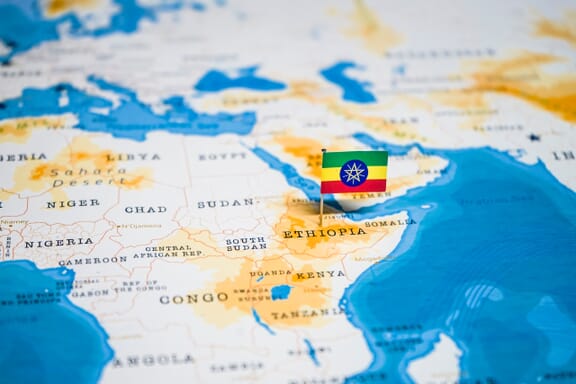Ethiopia is located in the Northern Africa region at latitude 9.145 and longitude 40.489673 and is part of the African continent.
The DMS coordinates for the center of the country are:
- 9° 8' 42.00'' N
- 40° 29' 22.82'' E
You can see the location of Ethiopia on the world map below:

Ethiopia Neighboring Countries
The neighboring countries of Ethiopia (ET) are:
- Djibouti (DJ)
- Eritrea (ER)
- Kenya (KE)
- Somalia (SO)
- South Sudan (SS)
- Sudan (SD)
Ethiopia is a landlocked country, which means it does not have direct access to the open ocean.
Ethiopia Key Facts
| Country | Ethiopia |
| Coordinates | Latitude: 9.145 Longitude: 40.489673 |
| Country Codes | Alpha 2: ET Alpha 3: ETH |
| Country Flag Emoji | 🇪🇹 |
| Int. Phone Prefix | +251 |
| Capital city | Addis Ababa |
| Continent Subcontinent | Africa Northern Africa |
| Country Area | 1,104,300 sq km |
| Population 2021 | 117,876,226 World Rank: 12 |
| Median Age | 18.5 |
| Life expectancy | 65 |
| Major languages | Oromo (official working language in the State of Oromiya) 33.8%, Amharic (official national language) 29.3%, Somali (official working language of the State of Sumale) 6.2%, Tigrigna (Tigrinya) (official working language of the State of Tigray) 5.9%, Sidamo 4%, Wolaytta 2.2%, Gurage 2%, Afar (official working language of the State of Afar) 1.7%, Hadiyya 1.7%, Gamo 1.5%, Gedeo 1.3%, Opuuo 1.2%, Kafa 1.1%, other 8.1%, English (major foreign language taught in schools), Arabic (2007 est.) |
| UTC/GMT Time | Number of time zones: 1
|
| Internet TLD | .et |
| Biggest Airport | Addis Ababa Bole International Airport (ADD) |
| Average temperature | 22.20 °C 71.96 °F |
| Administrative Divisions | 2 administrations 10 regional states |
| Political system | Federal parliamentary democratic republic |
Ethiopia Economy Facts
| World Bank Income Group | Low income |
| World Bank Region | Sub-Saharan Africa |
| Currency | Ethiopian Birr (ETB) |
| GDP in 2020 | $107.7 (billions of USD) World Rank: 59 |
| GDP per capita in 2020 | $936 World Rank: 171 |
| Major Industries / Economic Sectors | Agriculture, manufacturing, energy, services |
| Top 5 Import Countries | China, India, Saudi Arabia, United Arab Emirates, Germany |
| Top 5 Export Countries | China, United States, Saudi Arabia, Netherlands, India |
Biggest Cities in Ethiopia
Here are the largest cities in Ethiopia based on 2021 data:
| City | Population |
|---|
| Addis Ababa | 3,041,002 | Nazret | 324,000 | Gonder | 323,900 | Mekele | 323,700 | Awasa | 300,100 | Dire Dawa | 277,000 | Bahir Dar | 243,300 | Dese | 187,900 | Jima | 177,900 | Harar | 174,994 |
Map of Ethiopia with the Largest Cities
Map of Ethiopia

Ethiopia Related Content
- Ethiopia Regions Map
- Ethiopia Flag Map and Meaning
- What is the Capital of Ethiopia?
- Equator Map/Countries on the Equator
Image Sources and Copyright Information
- Ethiopia Flag Pin on Map: © hyotographics/Shutterstock